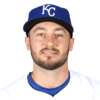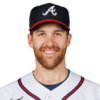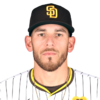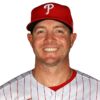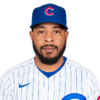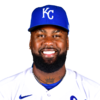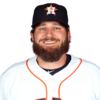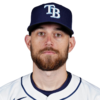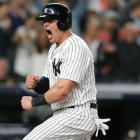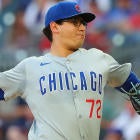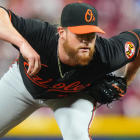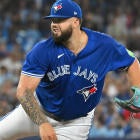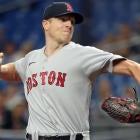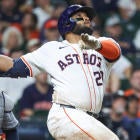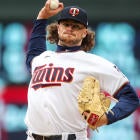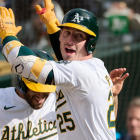Want to get a jump on the competition? Go to the CBS Sports app on your phone, open up "Settings" and sign up for Fantasy alerts to get the latest from our Fantasy baseball team as soon as it's available.
You know what sleepers are, right? The world thinks they'll be one thing, but they could be so much more. Pretty basic stuff.
What isn't basic is having to winnow down the list every year, because there are just too many players I like. It's why some of my sleepers wind up in the more narrowly defined breakouts column, so don't go thinking you have a complete picture of who's going to outperform his draft position just by reading this column.
But it's a good place to start. These 12 are straight- up underestimated, whether because they're hardly known to the baseball world or they've gotten a bad rap. They belong on your short list of players to target.
If there's anything that'll rescue a hitter from the downward spiral of age, it's a move to Coors Field — and especially this hitter, whose high-contact, line-drive, all-fields tendencies are so pronounced that a .300 batting average already feels something like a floor for him. He's taking those skills to a park where, because of a variety of environmental factors, it's not uncommon to see much of the lineup with a better-than-.330 BABIP — a range he already resides.
The soon-to-be 34-year-old's value would appear to be at a low point after a season in which he struggled to come back from knee surgery and saw his power numbers decline, and if he signed just about anywhere else, he would be an equally convincing bust candidate. But it turns out he went to the one and only place where fantasizing about him hitting .360 wouldn't be an intellectual betrayal.
You might wonder how anyone could sleep on a player who hit 35 home runs home runs last year. Yeah, it's because the Dodgers themselves did after acquiring Manny Machado and Brian Dozier last July, forcing their best hitter to that point to the bench against left-handers — an unfair banishment considering he had a .971 OPS against lefties at the time, finishing at .891 — which basically resulted in him starting just 29 of the team's final 55 games. Just imagine his numbers if he hadn't lost that time, resulting in what was an incredible (and believable) two-month surge being disrupted with playing-time concerns.
But because he did and because of the lingering perception he's a part-time player (despite the losses of Machado, Dozier, Yasiel Puig and Matt Kemp), he's not being rated like an elite slugger who had the fifth-best walk rate and fifth-best OPS of any hitter in 2018. I'm not so sure won't be the most productive first baseman in 2019.
When the Blue Jays dealt Russell Martin to the Dodgers in January, it confirmed what seemed like the obvious path for a team in rebuild mode: Danny Jansen is the man behind the plate now. His anointment is well deserved given the strides he made offensively during his past two minor-league seasons, and it comes at a time when Fantasy owners are desperate for anything resembling production behind the plate.
What he brings is a low-risk profile, a welcome departure from the Mike Zunino and Austin Hedges fakeouts of recent years. Jansen comes with the potential for a 1-to-1 strikeout to walk ratio and at least doubles pop — basically what Martin was during his best years in Los Angeles, or perhaps even closer to an in-his-prime Jonathan Lucroy. It's a profile that doesn't require big home run power to be impactful, especially at a position where so many of the hitters are their own worst enemies. That means Jansen should threaten for top-five numbers with full-time at-bats.
Hampson's minor-league track record paints him as the ideal leadoff man, which not only means he reaches base at a high rate but also that he's fast, offering the kind of stolen base potential (123 in 305) minor-league games that would make him answered prayer to Rotisserie owners if they could trust him to play. But there's no guarantee he gets the second base job, not with Rockies' penchant for blocking up-and-comers with fading veterans. All it would take is shifting Daniel Murphy to second base to free up first base for Ian Desmond or perhaps even Ryan McMahon. It's that uncertainty combined with the fact Hampson feels out of place in today's homer-happy environment that will keep him affordable on Draft Day.
But given that it's an ideal leadoff profile and given that Coors Field's BABIP-inflating ways make it almost impossible for a contact-oriented hitter like him to fail, there's a chance he plays enough to make an impact even in a super utility role, being capable of manning shortstop and center field as well.
Collin McHugh's banishment to the bullpen will last only a year thanks to the departures of Dallas Keuchel and Charlie Morton, and will prove to be time well spent if it renews his focus on what the Astros' prophetic team of number crunchers have been preaching to him since his arrival in 2014: The best application of his innate ability to spin the ball are the four-seam fastball and the curveball.
But he also brings new tricks, having picked up a slider from teammate Brad Peacock (who saw his career transformed by that same slider) that helped make McHugh's curveball even more effective in his bullpen role. It's a potentially devastating three-pitch mix that could yield career-best numbers for the starter version of McHugh. That's saying something considering he had a 2.73 ERA, 1.02 WHIP and 9.1 strikeouts per nine innings over 25 starts in 2014.
The Cardinals never seemed to think much of Luke Voit, and the Yankees didn't give up much to get him, which would seem to support the idea that what he did down the stretch, homering 15 times in 39 games with his new team, was a Shane Spencer-level flash in the pan. But what does it say that the Yankees, with their seemingly unlimited resources and constant presumption of contention, are basically handing him the opening day job, offering only the decrepit Greg Bird as a challenger? They know what we'll all soon discover: There may not be a right-handed slugger better suited for Yankee Stadium.
Voit is a strong man with massive forearms, but his power doesn't translate everywhere because he's so line-drive oriented (positioning himself for a high BABIP, meaning he's not just a pure slugger) and so opposite-field focused, pulling just five of his 15 home runs last year and 16.2 percent of his fly balls overall. Given how short that right-field porch is in his home venue, a 30-homer season seems like a modest estimate.
Joe Musgrove is known for living in the strike zone, issuing just 1.8 walks per nine innings last year, which makes for an efficient pitcher but not always an effective one. He took steps toward remedying that issue last August, though, trading out his sinker and cutter for his best two swing-and-miss pitches, the changeup and slider, over his final seven starts, and the effect was startling. He struck out 44 over 41 1/3 while issuing just four walks. The problem was he had a 5.23 ERA, ballooning his season mark from 3.41 to 4.06.
There's no doubt the change worked, though: His swinging-strike rate during that stretch compared to Jacob deGrom's and Blake Snell's full-season marks. And while it did make him more vulnerable to fly balls, some of his worst starts during that stretch were the three in which he didn't give up a home run, suggesting his struggles were more a product of bad luck. If he sticks to the approach and isn't discouraged by the outcome, he could tip the scales of that Gerrit Cole trade a little back in the Pirates' favor.
Corey Knebel had 16 saves last year to Jeremy Jeffress' 15. Between them and Josh Hader (12 saves), the Brewers found themselves a ninth-inning committee that worked. But as volatile as the individual closer has proven to be over the years, how much more likely is it that any one of the three links in this chain breaks, whether physically or mechanically or whatever else might remove him from the committee? All it takes is one of Knebel and Jeffress for the other to emerge as a stud closer.
I'm leaving Hader out of it because, while he'll always get his share, he's too valuable in a multi-inning role to become the outright closer, and he figures to be the highest drafted of the three anyway, limiting his sleeper appeal. But at a time when traditional bullpen roles are breaking down and dedicated closers are becoming less prevalent, there's value to investing a late-round pick in Knebel, who ended the year with 33 strikeouts to three walks in 16 1/3 scoreless innings, and Jeffress, who has elite ground-ball tendencies in addition to strikeout-per-inning stuff, as things currently stand. But the prospect of either overtaking the other makes it an advisable move.
Reyes split his time almost evenly between the majors and minors last year and hit a combined .299 with 32 homers and a .931 OPS in 144 games, which makes a pretty convincing case on its own. But factor in that he looked completely overmatched in his initial two-month stint in the majors before returning Aug. 5 to hit .318 with 10 home runs and a .933 OPS in his final 49 games, and you get a better idea of his potential.
Reyes struck out 40.4 percent of the time in that first stint, which no hitter could survive, but only 21.8 percent of the time in his second stint, which is comparable to Christian Yelich and much more in line with his minor-league stats. Add the fact that he pulled only a third of his batted balls and had an average velocity that ranked between Giancarlo Stanton and Mike Trout, and the 23-year-old is more than the hulking slugger his 6-foot-5 frame would suggest. Sure, he technically has to win a job first, but if his bat has a say, he will.
While it's true top prospect Kyle Tucker waits in the wings and on-base specialist Tony Kemp also figures to have a say, Tyler White stands as the heir apparent to Evan Gattis at DH, namely because ... well, he kind of took over before last year even ended. It was mostly a case of him wresting the job away, maintaining an OPS over 1.000 for about a two-month stretch from mid-July through mid-September, which seemed totally in character seeing as he hit .333 with 14 homers and a 1.013 OPS in 70 games for Triple-A Fresno.
Of course, the 28-year-old has gotten chances in the past and blown it, which is why the way he finished the season, batting .170 (8 for 47) in his final 15 games, has rendered him an afterthought in Fantasy still. When performing his best, there were no obvious red flags in his batted ball profile, and seeing as he hit .323 with 26 homers and 1.011 OPS over the first 5 1/2 months last season, majors and minors combined, it seems like more could go right than wrong for the cost of a late-round pick.
Lowe is perfectly positioned to slip through the cracks on Draft Day despite an incredibly productive season in which he hit .297 with 22 homers and a .949 OPS in 380 minor-league at-bats. He's patient and powerful, the most lethal combination of offensive skills — and a rare one at that among second basemen.
So why the lack of hype? Well, his major-league numbers won't blow you away, but he did have an inexplicable 0-for-19 start to his career. His .273 batting average and .884 OPS the rest of the way is validation enough for me. There's also the fact he's presently behind Joey Wendle on the depth chart, but he figures to play more of a Ben Zobrist role anyway, bouncing between second base in the outfield. And then there's the fact the traditional prospect lists continue to sell him short, though more because of his defensive profile than anything having to do with his bat. A top-10 performance at the position is distinctly possible.
In what was maybe the most shocking development in all of minor-league ball last year, Josh James went from being an organizational depth type destined to play out his 20s at Triple-A to one of the most overpowering pitchers in the minors, striking out 171 over 114 1/3 innings. The cause was a 10 mph jump in velocity that he credited to a sleep apnea diagnosis. Never underestimate the value of a good night's sleep, kids.
What makes James especially interesting, though, is that before he could blow 100 mph fastballs by hitters, he had to get by on deception and guile, and often did. So he offers the best of both worlds now: a power arm with a fully fleshed-out arsenal, which, if his late-season trial is any indication, could lead to big things every fifth day. His fastball and changeup both showed elite swing-and-miss potential, and his slider gave him a steady third offering. No reason the Astros wouldn't give the soon-to-be 26-year-old a shot, not with the all the openings in their starting rotation.











